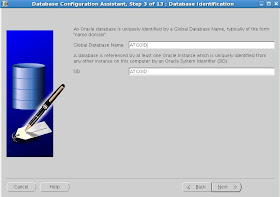If you do not create a starter database and later want to create one, or if you want to create additional databases, then you use DBCA. The Database Configuration Assistant enables you to
- Create a database
- Configure database options in an existing database
- Delete a database
- Manage database templates
There may be situations in which you want to create more than one Oracle database on the same host
computer. When you do this with DBCA, the new databases typically use the same Oracle home directory as the first database, but store database data files separately from those of the first database.
In [1], we describe the steps that we used to install a starter database with a Global Database Name (GDN) STAGE7. In this article, we will show how to add a new database (GDN: ATGOID) in the same Oracle home directory.
Steps
Here are our steps to create a new database named ATGOID using DBCA. Note that highlighted options are our selections. For more detailed descriptions, read [2].
- Welcome
- Operations
- Select the operation that you want to perform:
- Create a Database
- Configure Database Options
- Delete a Database
- Manage Tempaltes
- ASM configuration operations must be performed using Automatic Storage Management Configuration Assistant (ASMCA) from Oracle Grid Infrastructure home.
- Database Templates
- Select template to use for creation
- General Purpose or Transaction Processing
- Custom Database
- Data Warehouse
- Database Identification
- See Figure 1 (note that we didn't specify domain name here)
- Global Database Name: ATGOID
- SID: ATGOID
- Management Options
- Uncheck "Configure Enterprise Manager"
- We don't need this option for our benchmark
- Database Credentials
- Specify passwords for the following user accounts in the new database:
- SYS
- SYSTEM
- Network Configuration
- Select the listeners for which you want to register this database:
- Register this database with all the listeners
- Register this database with selected listeners only
- Note that we have created a new listener ATGOID using Net Configuration Assistant[3]
- Database File Locations
- Specify storage type and locations for database files:
- Storage Type: File System
- Storage Locations:
- Use Database File Locations from Template
- Use Common Location for All Database Files
- Use Oracle-Managed Files
- Recovery Configuration
- Specify Fast Recovery Area (Default)
- Database Content
- Default
- Initialization Parameters
- Typical (Default)
- Database Storage
- You can specify storage parameters for database creation. (Default)
- Creation Options
- Select the database creation options
- Create Database
- Save as a Database Template
- Generate Database Creation Scripts
- Generate Database Creation Scripts
Log File Location
Log files for the current operation are located at:
- $ORACLE_BASE/cfgtools/dbca/ATGOID
What to Expect?
After the creation of a new database, you should find the following information:
Database Information:
Global Database Name: ATGOID
System Identifier(SID): ATGOID
Server Parameter File name: $ORACLE_HOME/dbs/spfileATGOID.ora
If you look into initATGOID.ora, you can also find the following two entries:
*.db_domain=''
*.db_name='ATGOID'
Note that the domain name is an empty string because we didn't provide domain name at step 4.


No comments:
Post a Comment
Note: Only a member of this blog may post a comment.